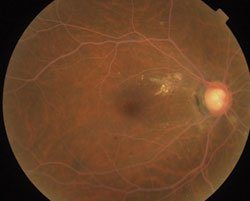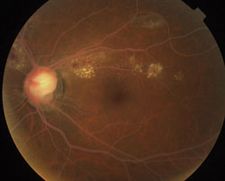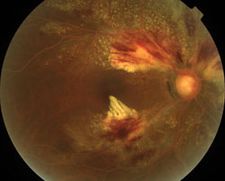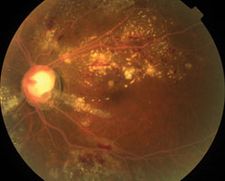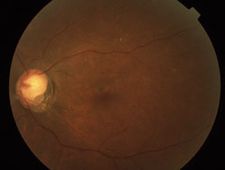Patient presents with type 2 diabetes, history of nonproliferative diabetic retinopathy
The woman previously received treatment for conditions including hypertriglyceridemia, hypertension and pancreatitis.
 David G. Telander |
 Charles H. Weber |
A 55-year-old Caucasian woman was referred by her primary care physician for diabetic retinopathy screening. The patient had an 18-year history of type 2 diabetes mellitus and pancreatitis. The patient also had a known ocular history of nonproliferative diabetic retinopathy without clinically significant macular edema, as well as increased optic nerve cup-to-disc ratio. She had been medically treated for hypertriglyceridemia, hypertension, pancreatitis, depression, trigeminal neuralgia and osteoarthritis. The patient had no particular ocular or visual complaints at her initial evaluation.
Upon examination, the patient’s best corrected visual acuity was 20/25-2 in the right eye and 20/20-2 in the left eye. Her IOP was normal, and the slit lamp examination of the anterior segment was unremarkable. Her dilated fundus examination revealed scattered retinal microaneurysms, intraretinal hemorrhages, macular hard exudates and lipemic-appearing retinal vasculature in both eyes (Figures 1 and 2). There was no retinal neovascularization, preretinal or vitreous hemorrhage, or macular edema in either eye.
Laboratory testing performed at that time was notable for total cholesterol 1,050 mg/dL (normal: 0 to 200 mg/dL), HDL cholesterol 20 mg/dL (normal: 35 mg/dL or higher), triglyceride 21,588 mg/dL (normal: 35 to 160 mg/dL), blood glucose 174 mg/dL (normal: 70 to 110 mg/dL), amylase 18 U/L (normal: 30 to 140 U/L), lipase 17 U/L (normal: 13 to 51 U/L), and glycosylated hemoglobin 11.3% (normal: 3.9% to 5.9%).
|
|
|
|
Figures 1 and 2. Color fundus photographs of both eyes depicting lipemic retinal vasculature and retinal exudates.
Images: Telander DG, Weber CH
|
|
The diagnosis
This patient’s clinical picture was consistent with lipemic retinopathy with coexistent severe nonproliferative diabetic retinopathy. The patient was referred back to her primary care physician for re-evaluation of her hyperlipidemia, diabetes mellitus and pancreatitis. The patient’s primary care physician referred her to an endocrinologist and continued her on fenofibrate, ezetimibe/simvastatin, fish oil, extended-release niacin, mealtime Humalog (insulin lispro injection, Lilly) and nightly Lantus (insulin glargine, sanofi-aventis).
The endocrinology service added metformin to the patient’s medication regimen and increased her mealtime Humalog. Despite attempted pharmacologic control, the patient’s hypertriglyceridemia persisted and her diabetes remained poorly controlled.
The patient was lost to follow-up for several months, and by the time of reevaluation 8 months after her initial presentation, the patient had developed clinically significant macular edema in the left eye with subfoveal hard exudates, with increased retinal hard exudates and persistence of lipemic-appearing retinal vasculature in both eyes. In the subsequent months, the patient was treated with multiple intravitreal injections of Avastin (bevacizumab, Genentech) in an effort to treat any underlying VEGF-driven development of the macular hard exudates. While these treatments caused a decrease in her central macular thickness as measured by optical coherence tomography, there was no notable observed decrease in the overall macular hard exudate load in either eye. In fact, the amount of macular hard exudate increased and reached its most severe state 16 months after the patient’s initial presentation, at which time her vision was 20/400 in the right eye and 20/30 in the left eye (Figures 3 and 4). The patient was referred for therapeutic plasma exchange (TPE) in an attempt to aggressively treat her dyslipidemia.
|
|
|
|
Figures 3 and 4. Color fundus photographs of both eyes showing persistent lipemic retinal vasculature with extensive retinal exudates and intraretinal hemorrhages.
|
|
|
|
|
|
Figures 5 and 6. Color fundus photographs of both eyes showing marked reduction in retinal hard exudates after undergoing a series of therapeutic plasma exchanges.
|
|
The patient was treated with TPE, exchanging one plasma volume per procedure and replacing 100% of the volume with 5% albumin. She was treated with three exchanges per week for the first 2 weeks, after which therapy was tapered to once per week, for a total of 13 exchanges. As a result of TPE, the patient’s triglyceride level decreased remarkably (343 mg/dL at last measure) but did not return to normal level.
In addition to plasmapheresis, the patient underwent focal macular laser photocoagulation, directed at leaking microaneurysms, to the right eye on two separate occasions.
After the 13 TPEs, the patient’s visual acuity stabilized at 20/30 in the right eye and 20/25 in the left eye, with a notable decrease in the extent of retinal hard exudates (Figures 5 and 6).
Retinal hard exudates form when increased vascular permeability allows the leakage of fluid and lipoprotein into the retina from retinal capillaries, with the subsequent resorption of edema resulting in the precipitation of lipid residues within the outer plexiform layer of the retina.
The Early Treatment Diabetic Retinopathy Study demonstrated that elevated serum lipid levels are associated with an increased risk of retinal hard exudate in persons with diabetic retinopathy, and increasing amounts of exudate seem to be associated with increased risk of visual loss. Furthermore, there is evidence that the lowering of serum lipids can reduce retinal hard exudates and therefore any resulting visual dysfunction.
This patient’s lipemic retinopathy with vision-threatening macular hard exudates resulted from incompletely controlled hypertriglyceridemia compounded by underlying diabetes mellitus and pancreatitis. In order to restore this patient’s vision and reduce her macular hard exudate load, a multidisciplinary approach was required to not only treat the ophthalmic manifestations of her disease, but also to treat the underlying conditions.
References:
- Chew EY, Klein ML, Ferris FL III, et al. Association of elevated serum lipid levels with retinal hard exudate in diabetic retinopathy. Early Treatment Diabetic Retinopathy Study (ETDRS) Report 22. Arch Ophthalmol. 1996;114(9):1079-1084.
- Cusick M, Chew EY, Chan CC, Kruth HS, Murphy RP, Ferris FL 3rd. Histopathology and regression of retinal hard exudates in diabetic retinopathy after reduction of elevated serum lipid levels. Ophthalmology. 2003;110(11):2126-2133.
- Fong DS, Segal PP, Myers F, Ferris FL, Hubbard LD, Davis MD. Subretinal fibrosis in diabetic macular edema. ETDRS report 23. Early Treatment Diabetic Retinopathy Study Research Group. Arch Ophthalmol. 1997;115(7):873-877.
- Gordon B, Chang S, Kavanagh M, et al. The effects of lipid lowering on diabetic retinopathy. Am J Ophthalmol. 1991;112(4):385-391.
- Little HL, Wall RT, Myers B, et al. Intensive plasmapheresis in the treatment of diabetic retinopathy. Arch Ophthalmol. 1983;101(12):1889-1893.
- Charles H. Weber, MD, and David G. Telander, MD, PhD, can be reached at University of California Davis Eye Center, 4860 Y St., Suite 2400, Sacramento, CA 95819; 916-734-6602; email: charles.weber@ucdmc.ucdavis.edu or david.telander@yahoo.com.

